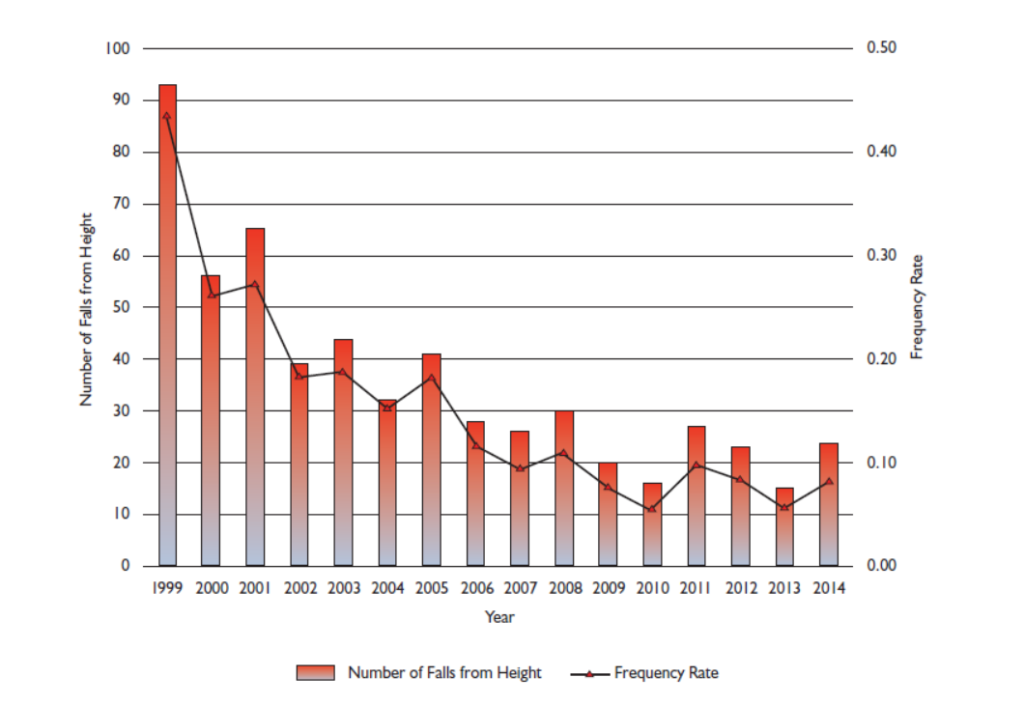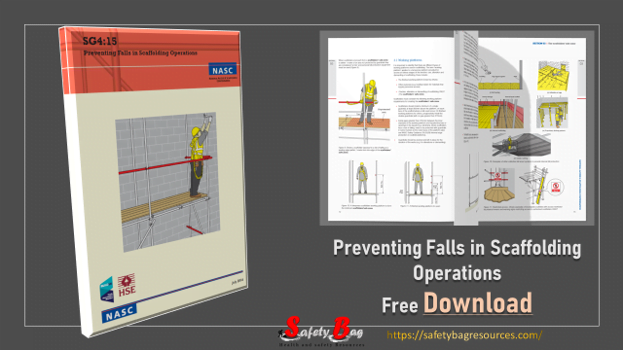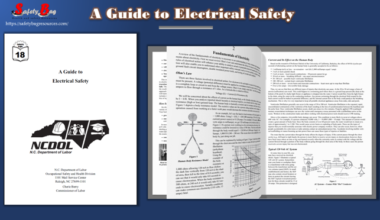
Preventing Falls in Scaffolding Operations Safety Guidance 4: 2015 Published by National Access & Scaffolding Confederation (NASC). The preparation of this NASC Guide to Preventing Falls in Scaffolding was entrusted to The NASC SG4 Working Party by the Council of the National Access and Scaffolding Confederation. This guide takes the form of recommendations and guidance.
It should not be quoted as if it were a specification. It does not
purport to include all the necessary provisions for a contract and users are responsible for their application.
The guide has been written on the assumption that the execution of its provisions is entrusted to appropriately qualified and experienced people and that the construction and supervision of scaffolds will be carried out by capable and experienced organizations. NASC and Simian Risk Management Limited shall be under no liability of whatsoever kind however caused whether or not due to the negligence or wilful default of NASC or their servants or agents arising out of or in connection with this document or any part thereof.
Also Read: Suspended Scaffold Pre-Operation Inspection Checklist
Read the Book Preventing Falls in Scaffolding Operations by Flipping the File below :
Falls from height account for almost half of the fatal accidents in the construction sector. Falling from height is a significant risk faced by scaffolders when erecting, altering, or dismantling scaffolding during most scaffolding operations. The NASC and HSE acknowledge that scaffolders have to work in hazardous situations, and this guidance note accepts
that employers have a responsibility to ensure that adequate measures are provided for employees during scaffolding operations to eliminate or minimize those risks.
In recognition of the significant hazards and risks that
scaffolders are exposed to day to day, the NASC has
produced this edition of Safety Guidance Number 4 (SG4) as ‘scaffolding industry good practice’ for work at height.
This updated guidance reflects the challenges facing our industry through new fall protection technology, Technical Guidance (TG20), and changing methods of construction and maintenance.
Also Read: CAL/OSHA Scaffold Guide for safe use of supported Scaffolds
The NASC also recognizes that statistics1 have shown falls from height rarely involve scaffolders from our membership who are working from scaffold structures they have
constructed themselves. We also recognize that the instances of fatal and RIDDOR 2 specified injuries resulting from falls of scaffolders have significantly reduced since the introduction of SG4 in the mid-1990s. The revisions of SG4 in 2000, 2005,2010, and again in 2015 have seen changes to the methods of working that have been adopted by the industry. Since 2000 there has been a 78% reduction in the number of falls recorded from scaffolding operations – from 93 in 1999 to 24 in 2014. This reduction is in spite of a 29% increase in the number of operatives working within the NASC membership, which represents an 82% reduction in the accident frequency rate during this period ( Figure 1).

Also Read: Books: OSHA-Is it Safe to Enter Confined Space?
The Content of the Preventing Falls in Scaffolding Operations:
- Contents iii
- Figures v
- Foreword vii
- Preface viii
- 01 Introduction 1
- 02 Planning for work at height 3
- 2.1 Competence and capability 6
- 2.2 Training and instruction 7
- 2.3 Supervision 7
- 2.4 Site inspection and risk assessment 8
- 2.5 Rescue planning 8
- 2.6 Collective fall protection (3rd Party) 8
- 2.7 Weather conditions 8
- 2.8 Temporary works design 9
- 2.9 Scaffolding operatives’ responsibilities 10
- 03 The scaffolders’ safe zone 11
- 3.1 Working platforms 12
- 3.2 Methods of constructing a scaffolders’ safe zone 16
- 3.2.1 Scaffolders’ step 17
- 3.2.2 Push up advanced guardrail tool 18
- 3.2.3 Proprietary advanced guardrail systems (AGS) 19
- 3.2.4 Protected traversing 21
- 3.2.5 Short-lift system 22
- 3.2.6 Tube and fitting frame type AGS 23
- 3.2.7 Tube and fitting horizontal type AGS 24
- 04 Other scaffolding applications 25
- 4.1 Scaffolding from a mobile elevating work platform (MEWP) 25
- 4.2 Proprietary system scaffolding 26
- 4.3 Shorter lifts (Bricklayers’ lifts) 26
- 4.4 Tall lifts (floor height lifts, pavement lifts, and gantries) 27
- 4.5 Birdcage access scaffolding 29
- 4.6 Bridging with beams 29
- 4.7 Loading bays 30
- 4.8 Protection fans and cantilevered systems 30
- 4.9 Chimney stacks scaffolding (roof saddles) 32
- 4.10 Temporary roofs 33
- 4.11 Hoist towers and debris chutes 34
- 4.12 Temporary edge protection 34
- 4.13 Falsework, formwork, and other temporary structures 36
- 05 Methods of access and egress 37
- 06 Personal fall protection equipment 39
- 6.1 Fall arrest harnesses and lanyards 39
- 6.2 Single fall arrest lanyards 41
- 6.3 Double fall arrest lanyards 41
- 6.4 Anchor points, connectors, and anchor devices 43
- 6.5 Anchor points 43
- 6.6 Suitable scaffold anchor points 43
- 6.7 Unsuitable scaffold anchor points 44
- 6.8 Anchoring to standards 44
- 6.9 Anchorages to proprietary scaffolding systems 45
- 6.10 Guidelines for anchorages on other structures 45
- 6.11 Anchorages to lightweight mobile access towers (MATs) 45
- 6.12 Inertia reels 46
- 6.13 Hybrid self-retracting lanyards 47
- 6.14 Horizontal line systems 47
- 6.14 Inspection and maintenance of personal fall arrest equipment 48
- 6.15 Personal fall arrest equipment manufacturers’ instructions 48
- 07 Rescue 49
- 7.1 Assisted rescue without specialist rescue equipment 49
- 7.2 Specialist rescue equipment 50
- 7.3 Rescue training 51
- 08 Appendices 52
- Relevant Health & Safety Law 52
- British & European Standards 53
- References and further reading 54
- Acknowledgments 55
( Also Read : Books: CAL/OSHA Pocket Guide for Construction Industry )
Download The Book
Preventing Falls in Scaffolding Operations
More Downloads
- Books: How to Plan for Workplace Emergencies and Evacuation
- Books: Firefighting Precautions at Facilities with Combustible Dust
- Books: A Guide to Electrical Safety
- Books: Preventing Falls in Scaffolding Operations
- Handbook: Worker’s Safety
- Books: A Guide to Safety in Confined Spaces
- Books: OSHA-Hazard communication for small Entity
- Books: OSHA-Permit Required Confined Spaces
- OSHA: Underground Construction (Tunneling)
- OSHA Recommended Practice of Health and Safety programs in construction
- Books: OSHA-Is it Safe to Enter Confined Space?
- Books: General Industry Digest
- Books: A Guide to Bloodborne Pathogens in the workplace
- Books: 5-Minute Workplace Safety Talks
- CAL/OSHA Scaffold Guide for safe use of supported Scaffolds
- Books: CAL/OSHA Pocket Guide for Construction Industry
- Books: Let’s Talk Safety
- Books: OSHA Fall Protection Toolbox Talks and Trainer Guide


